

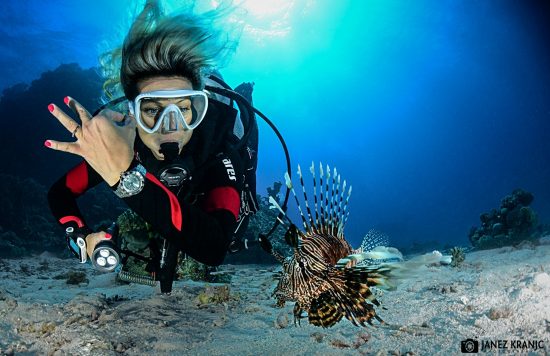
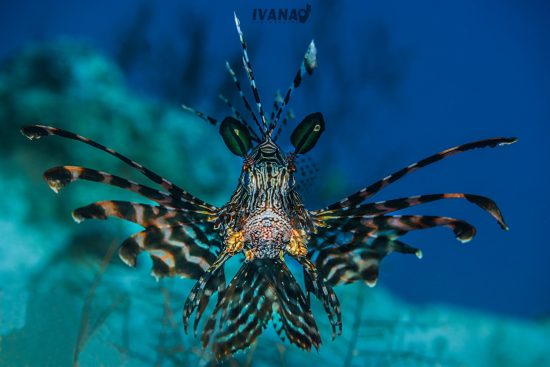
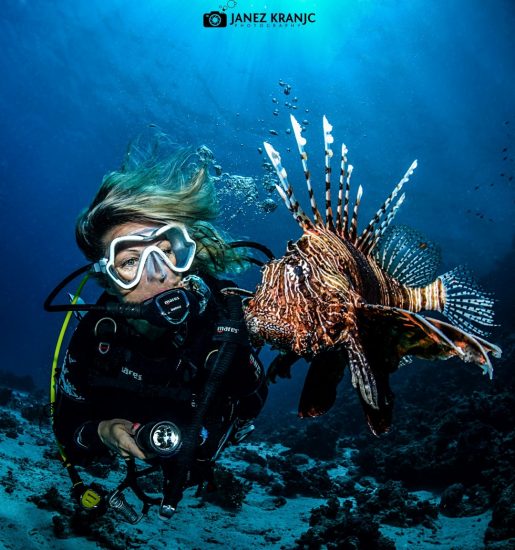
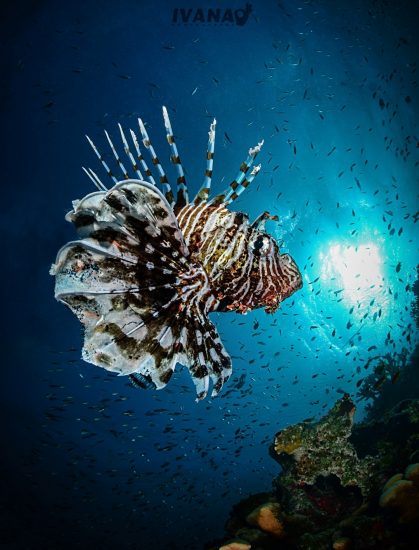
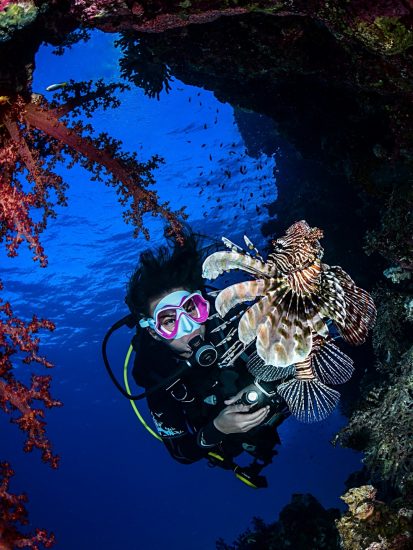
Lionfish (Pterois spp) are represented by 12 very closely related species.
These majestic and amazing looking fish are among underwater photographers favourites due to their white or cream coloured bodies with distinctive red/brown stripes across their whole body in different configurations depending on species.
Their fan-like pectoral fins and long spines along their dorsal make them look like they are the royals of the reefs.
They can grow as big as 50cm in length, weighing up to 1.5kg and live for five to fifteen years.
An average lionfish female releases up to 15,000 eggs in two mucus-filled clusters every one to two days which means a lot of lionfish in a short space of time.
These attractive looking fish are native to the coral reefs of the South Pacific and the Indian Ocean where they use their fins to corner and ambush their prey.
They usually move slowly using their dorsal and anal fins for movement.
During the day they wait under ledges and inside crevices for their victim to fall into their trap and slowly follow them, cornering their prey by blocking the exit with the pectoral fins. They also blow jets of water to distract and confuse their prey while approaching them.
Their fantastic colouring and venomous dorsal spines are designed to deter possible predators and position them as one of the top predators of tropical reefs.
They are known to consume more than 70 species of fish; they are not fussy eaters, and they eat more than they need as their stomach can expand by 30 times its normal size.
While they are native to the Pacific and the Indian Ocean, two of the species have made themselves at home and become a serious problem in the western Atlantic and also in the Mediterranean around Cyprus and Malta. Here they have become an invasive species as they do not have natural predators such as large groupers which are no longer very common due to overfishing.
Moray eels, different species of groupers, blue-spotted cornet fish and some sharks have been documented eating these beautiful creatures, but as they can find more accessible food to catch, they think twice before eating lionfish and leaving them to devour different species of fish.
They are perceived as a threat to the overall well being of coral reefs as they eat a lot of juvenile fish residing around coral reefs.
They were first detected in the Atlantic around the coast of Florida in the 1980s and are thought to be the effect of escape or release from an aquarium as they are very popular ornamental fish but quite hard to maintain.
They do not seem to mind the colder waters and seem very comfortable living around the reefs and wrecks of the warmer parts of the Atlantic, off the coast of the U.S., Gulf of Mexico and the Caribbean.
Lionfish are capable of reducing reef life by 79%. They also eat the same fish species as commercially important species such as snappers and groupers. Therefore, their presence and ferocious appetite could affect fisheries long term. Coral reefs are already under pressure from temperature increase, ocean acidification and pollution. Consequently, another threat in the form of an invasive species is not an ideal situation.
As much as divers and spearfishers are encouraged to hunt for lionfish, and several programmes have been established to promote education and encourage the introduction of lionfish to fish markets, and lionfish derbies are organised in different locations, the invasion of the lionfish continuous.
The chances of food poisoning from eating lionfish are very small as the venom is just located in the spines of the fish and the flesh which is white tender meat is delicious.
There is no way that large-scale harvesting of lionfish is ever going to be viable as they live in a reef environment which is not accessible to large-scale fisheries, but there is an opportunity for small-scale fishing to be able to provide a new fish species to the fish markets by capturing the Lionfish.
Their venom can cause seriously unpleasant symptoms which I have experienced first hand (literally), and yes it does feel like your bones are breaking after a sting from the Lionfish. However, a hot water treatment and antihistamines with painkillers sorted the problem quite quickly. I was lucky as my sting was not severe, but there have been cases of paralysis and death due to contact with Lionfish venom so they should be approached with caution. They do not attack but are territorial, and most stings are accidental, mainly affecting fisherman and divers hunting for them. Specialised confinement units for trapped Lionfish reduce the chances of accidental injury.
From personal experience, I can say that it does seem that lionfish are becoming smarter and going deeper below recreational divers depths and also seem to be developing avoidance behaviour which has not been noticed before.
Scientists are currently working on new anti-lionfish strategy in the form of genetic modification to produce sterile males to minimise the rate of reproduction.
It is incredible to think that such beautiful creatures, a subject of so many beautiful pictures, could pose such a threat when not in their natural habitat.
Author: Bogna Griffin, BSc Freshwater and Marine Biology, GMIT, Galway, Ireland
Photos: Mares Ambassadors Ivana O.K & Janez Kranjc
Logistics:
https://www.facebook.com/GulfDivers/?fref=ts
 Ivana and Janez
Ivana and Janez 1st December 2017
1st December 2017 Hurghada, Qesm Hurghada, Governatorato del Mar Rosso, Egitto
Hurghada, Qesm Hurghada, Governatorato del Mar Rosso, Egitto